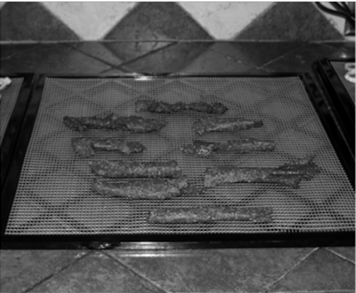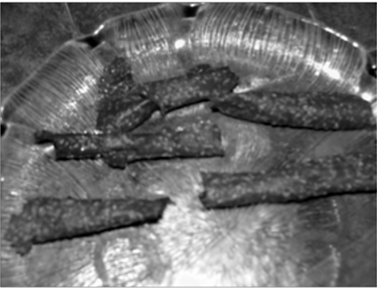Up until now, the instructions have only been for drying whole pieces of each fruit, vegetable, and herb. But there are other ways of dehydrating to produce other types of results.
What are Leathers?
Before you learn more on how to make them, it would be helpful to have a better understanding of what fruit or vegetable leather is.
Leathers are made by dehydrating a layer of fruit or vegetable purée until it is pliable, just like a piece of leather. Fruit is the most common type of leather, although you certainly can experiment and make some interesting ones out of vegetables as well. They usually are eaten as is, a handy snack, although you can use your leathers as a way to preserve food for other uses as well.
Fruit leather can be purchased as a children’s treat or snack, usually called a “fruit roll-up” or something similar. These are made with fruit but also contain a great deal of sugar. You can make your own with pure fruit that taste just as good if not better. When wrapped in wax paper, they are just as portable as any store-bought versions.

Photo courtesy of Douglas and Sherri Brown
Making Leather
There is more processing involved in making leather than just washing and chopping your fruits and vegetables for the dehydrator.
Preparing fruits and vegetables for leathers
One of the great things about making leather is that you can make use of any produce that is too ripe for conventional dehydrating. Once they have gotten too soft, most fruits will not dry well as slices, but they can be turned into wonderful leather instead.
Your fruit is going to be puréed; so, you do not need to worry about accurate slicing or chopping. Just remove any bruises, brown spots, and stems before you begin. Most fruits and vegetables are peeled if they have a tough peel, but softer foods will not need that step.
Some fruits can be puréed raw, and some may be cooked. Both will dry well into leather, but the taste will be different. The specific details will be covered in the next section.
Leather-making methods
Once your produce is cleaned up, you will need to make a purée. Cooked foods will purée more easily, but just about any fruit or vegetable will purée in a blender, even when raw. Harder vegetables, such as carrots, will be smoother if you cook them first.
Your purée needs to be thin enough to be pourable; so, add extra water or fruit juice to thin it out if necessary. There is no precise way to measure the right consistency. It may take a few trial runs to see how well it dries. You will need roughly 2 cups to fill an average dehydrator, but you can always adjust this to suit how much room you have to dry with.
Specific recipes will come later in this chapter, but be aware that you can mix any fruits and vegetables together when making your purées. There is no need to keep everything separate. Unlike dehydrating other types of fruit and vegetables, there is no difference in drying times once puréed. So, any kind of leather will take the same time to dry regardless of what kind of food you have used as the ingredients.
Spread your purée on a sheet of wax paper cut to fit the trays in your dehydrator. It should be no thicker than 1/8 inch, although it can be tough to measure a puddle of purée accurately. Thinner layers will dry faster, but you can end up with it stuck to the wax paper if it is not thick enough to hold together when you go to peel it back. It will take about 12 hours to dry your leather at a temperature of 120 F. You should dry your leather pieces for about six hours. Then peel from the paper, flip over each piece, and continue to dry until neither side is sticky.
You also can use the sun to make leather, but the sticky nature of the purée does make it hard to keep your trays clean. Insects and debris will be a constant problem. Set your trays up some place in full sun where they will not be disturbed, and cover them with cheesecloth. Line with wax paper again, and dry the same way as in a dehydrator, except flip over the pieces after one day of drying. Continue for another full day after that.
Last, you also can use your oven to dry leathers. Use a paper-lined baking sheet, and set your oven to 120 F. As with the other methods, you will have to peel your leather from the paper halfway through so it dries properly. In the oven, it will be about eight hours before you flip it and another eight hours after.
You cannot safely make fruit or vegetable leather with simple air drying. The liquid state of the purée will mold too quickly for this to work.
The biggest challenge with making leather is having it stick to your trays or sheets of paper. A light brushing of oil on your wax paper can help. Also, you will have a better time of removing the paper if you flip it over so the drying leather is on the bottom, and then peel the paper back. It works better than trying to peel the leather off directly.
Storing leathers
As long as your pieces of leather are no longer sticky, they will last many months. The easiest way to store them is to keep them on their wax paper backing and roll them up. You can use scissors to cut both the leather and the paper to make the tubes the right size for a container.
Properly dried fruit or vegetable leather can be stored at room temperature, although you also can store it in the fridge if you prefer the cool taste when eating it as a snack.
Recipes for Making Leathers
Because the actual technique is going to be primarily the same no matter what kind of leather you are making, these recipes are more about options for mixing various fruit and vegetable combinations together to create new flavors.

Photo courtesy of Douglas and Sherri Brown
On the other hand, there are also a few examples of leathers you can make for rehydrating later. In those cases, further instructions are included.
You also can use yogurt to make a creamier type of leather. Look to Chapter 11 on dairy for instructions on yogurt leathers.
Spiced Apple Leather
You can make plain apple leather with just fruit and juice, but the addition of a few spices can really improve the flavor.
• 4 apples
• ½ cup water or apple juice
• ¼ tsp. cinnamon
• 1/8 tsp. cloves
Chop and cook the apples until soft; then combine everything in a blender or food processor to purée. Dry by your preferred method. You can substitute store-bought applesauce for this recipe as long as you have about 2 cups worth. You will not need any extra water or juice in that case.
Banana and Chocolate Leather
Maybe not quite as healthy as the all-fruit mixtures, but a little chocolate goes well with the mellow flavor of banana.
• 4 bananas (very ripe is best)
• 2 Tbsp. cocoa powder
• 1 Tbsp. white sugar
Mash or purée bananas, and mix in cocoa and sugar until it is all combined and smooth. Dry until no longer tacky or sticky.
Mango Strawberry Leather
A vibrant mix of tart fruits will make a tasty snack leather.
• 1 cup chopped mango
• 1 cup strawberries
You also can adjust the ratio if you prefer one flavor to the other. Purée until smooth and dry.
Bumble Berry Leather
A little bit of everything for a summer-fresh mix of fruit.
• ¼ cup strawberries
• ¼ cup blackberries
• ¼ cup blueberries
• ¼ cup raspberries
Purée everything, and dry as per the standard instructions. You might want to put the mixture through a food mill or fine strainer to remove extra seeds.
Tropical Fruit Leather
• 1 cup papaya chunks
• 1 cup pineapple chunks
• 1 large banana
Pineapple can be a little fibrous for this; so, make sure you run it through the blender enough to really have a smooth purée.
Sweet Apple Berry Leather
Fruit on its own is usually quite sweet, but this leather adds a little honey to make an even sweeter treat. There is a nice blend of different fruits and some spice.
• 3 cups chopped raw apples
• 1 cup raspberries
• 3 Tbsp. orange juice
• 2 Tbsp. honey
• 1 tsp. cinnamon
• ½ tsp. lemon juice
Combine the berries and apples, and then blend until smooth. Stir in the remaining ingredients, and dehydrate into leather. This makes a larger batch than the other recipes, so you may have to load up your dehydrator twice.
Peach and Pear Leather
• 1 cup chopped peaches
• 1 cup chopped pears
• ½ tsp. cinnamon or allspice
Use a blender to puree this until smooth, and then dehydrate like the others.
Tomato Sauce Leather
Here is a good example of non-fruit leather that is not supposed to be eaten as a snack in its dry form. This recipe is a dried tomato sauce that can be remade into sauce by heating again in water.
• 2 cups of your favorite tomato or spaghetti sauce
No other ingredients are required, and you can use either store-bought or homemade sauces for this. If you are using a chunky sauce, run it through the blender before drying to make sure you have an even consistency. Then just dry as you would any fruit leathers. Store it the same way as well.
When you want to make tomato sauce with your leather, just combine equal parts water and pieces of leather and simmer until it has all dissolved.
Sweet Potato Leather
The natural sweetness of sweet potatoes makes them a unique vegetable, and when made into leather, it can be eaten as a healthy snack. You also can stir pieces of sweet potato leather into soups or casseroles to add a little bit of extra nutrients without having to cook more sweet potatoes.
• 2 cups cooked sweet potatoes
Purée until smooth and dry. Because it is starchier than fruit and most other vegetables, it might take longer to dry than usual. A better timing would be eight hours, flip over, and then dry for another eight hours.
Pumpkin Pie Leather
Here is a tasty one for the fall that uses vegetables but is still as sweet as fruit leather.
• ½ cup applesauce
• 2 cups pumpkin purée
• 1 tsp. cinnamon
• ½ tsp. ginger
• ¼ tsp. nutmeg
• ¼ tsp. cloves
• 1 Tbsp. molasses
• 2 Tbsp. brown sugar
Mix ingredients, and dry as per the fruit leather instructions. If you are using chunky applesauce, you might want to run it through the blender so you have a smoother mixture. You can eat this leather dry as a snack.
